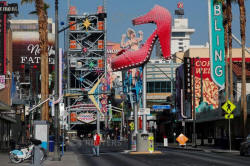Las Vegas is booming again, and bracing itself for next
slump
 Send a link to a friend
Send a link to a friend
 [September 11, 2018]
By David Randall [September 11, 2018]
By David Randall
LAS VEGAS (Reuters) - Diane Han is trying
to leave the Las Vegas of her childhood behind.
Her mother is a blackjack dealer at Caesar's Palace, one of the
mega-casinos on the Las Vegas Strip, while her father works in
housekeeping at another. Han, 25, grew up in Las Vegas, but went to
college in the Bay Area for college and spent a year there working as a
biochemist.
Yet she returned to enroll as a member of the first class at the
University of Nevada, Las Vegas School of Medicine. The school opened
last year to address a chronic shortage of doctors in Southern Nevada
and broaden the city’s economic base.
Few cities were hit as hard as Las Vegas by the 2008 financial crisis
and recession, which eroded consumer spending on the sort of fast
thrills the city had to offer and left it with the highest foreclosure
rate in the nation. Home prices plummeted 62 percent from their peak in
2006 to their bottom in 2012, according to data from ATTOM Data
Solutions, a real estate tracking firm.

Now Han is part of a group of medical students whose decision to stay
and practice in Las Vegas after graduation may give the city hope that
it can reduce its reliance on casinos.
“We are in an early stage of building what could be a start-up culture
here," Han said. "We’re trying to make it a real city, not just a
transient one.”
Nevada as a whole lost more jobs in relation to its workforce than any
other state, with more than 70 percent of those losses in the Las Vegas
region. There, unemployment rate hit 14.2 percent at the depth of the
recession, well above the national peak of 10 percent and nearly triple
where it was before the downturn began in 2007.
Though construction cranes once again rise above casinos along the
Strip, Las Vegas is trying to prepare for the next downturn – whenever
that may be - by trying to wean itself off the reliance on housing and
hospitality and turning to industries ranging from professional sports
to medical care.
"We are trying to build a world class city," says Mayor Carolyn Goodman,
citing investments in infrastructure and efforts to woo new businesses.
Yet the question remains whether it will be enough.
Other hard-hit Sun Belt cities, such as Orlando and Phoenix have
outpaced Las Vegas in job growth since the crisis and have more
diversified economies, said Steven Pedigo, a professor of economic
development at New York University. (Graphic: https://tmsnrt.rs/2CIaReC)
"They were absolutely killed and I think it's fair to say that they are
only starting to rebound now," Pedigo said about Las Vegas. "If Las
Vegas doesn't build some buffer around its economy it will always be a
boom and bust town."
BET ON HEALTHCARE
Over the last five years, businesses including Amazon-owned Zappos, data
company Switch Inc <SWCH.N> and Amazon.com Inc <AMZN.O> itself have
opened new headquarters or regional hubs in the Las Vegas metro area,
bringing approximately 3,000 new jobs thanks in part to more than $15
million in tax incentives. But the University of Nevada's medical school
is at the core of the city's vision of its future.
[to top of second column] |

A general view of the old Las Vegas Strip in Las Vegas, Nevada,
U.S., August 27, 2018. Picture taken August 27, 2018. REUTERS/Mike
Blake

By 2030, it is expected to add 8,000 jobs and contribute $1.2 billion annually
to the metro area's $111 billion economy. Established with $27 million in state
funding, the school now has 143 full-time faculty and employs over 1,000, said
Dr. Barbara Atkinson, the school's founding dean.
"The major impetus to start the medical school was the economic impact," she
said. "Each new physician that comes here usually hires between two and five
other staff people, and they have more than enough patients.”
The city and state have also invested more than $36 million in infrastructure,
such as street improvements, and marketing and has another $97 million planned
to build out the Las Vegas Medical District. The city expects the cluster of
medical office buildings and hospitals four miles (6.44 km) north of the Strip
will add 16,000 jobs and contribute $2.4 billion to the local economy annually
by 2030.
The improvements are paid in part by bonds issued by a regional transportation
agency that administers the Las Vegas region's first planning blueprint to
handle what it expects to be a nearly 45 percent population growth by 2045.
Already, there are signs that the economy is shifting. Around 100,000 jobs are
in health and education-related fields, an increase of more than 50 percent from
10 years ago, according to the Bureau of Labor Statistics. At the same time,
construction employment is down 38 percent at about 65,000.

The influx of newcomers into Clark County, Nevada's most populous county with
2.25 million residents, has helped push housing prices up more than 15 percent
this year so far, though average prices are still below pre-crisis peaks.
Real-estate listing firm Zillow estimates prices will rise another 8 percent
over the next 12 months, driven in part by continued arrivals of Californians
priced out of their markets.
Whether those gains will last, however, is a matter of debate, with Fitch
Ratings recently describing the metro area as the most overpriced market in the
country.
“Las Vegans once thought we were recession-proof,” said Stephen Miller, a
business professor at UNLV. “We learned our lesson and made some progress, but
we need to make a lot more.”
(Reporting by David Randall; Editing by Jennifer Ablan and Tomasz Janowski)
[© 2018 Thomson Reuters. All rights
reserved.] Copyright 2018 Reuters. All rights reserved. This material may not be published,
broadcast, rewritten or redistributed.
Thompson Reuters is solely responsible for this content. |